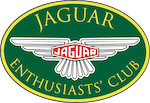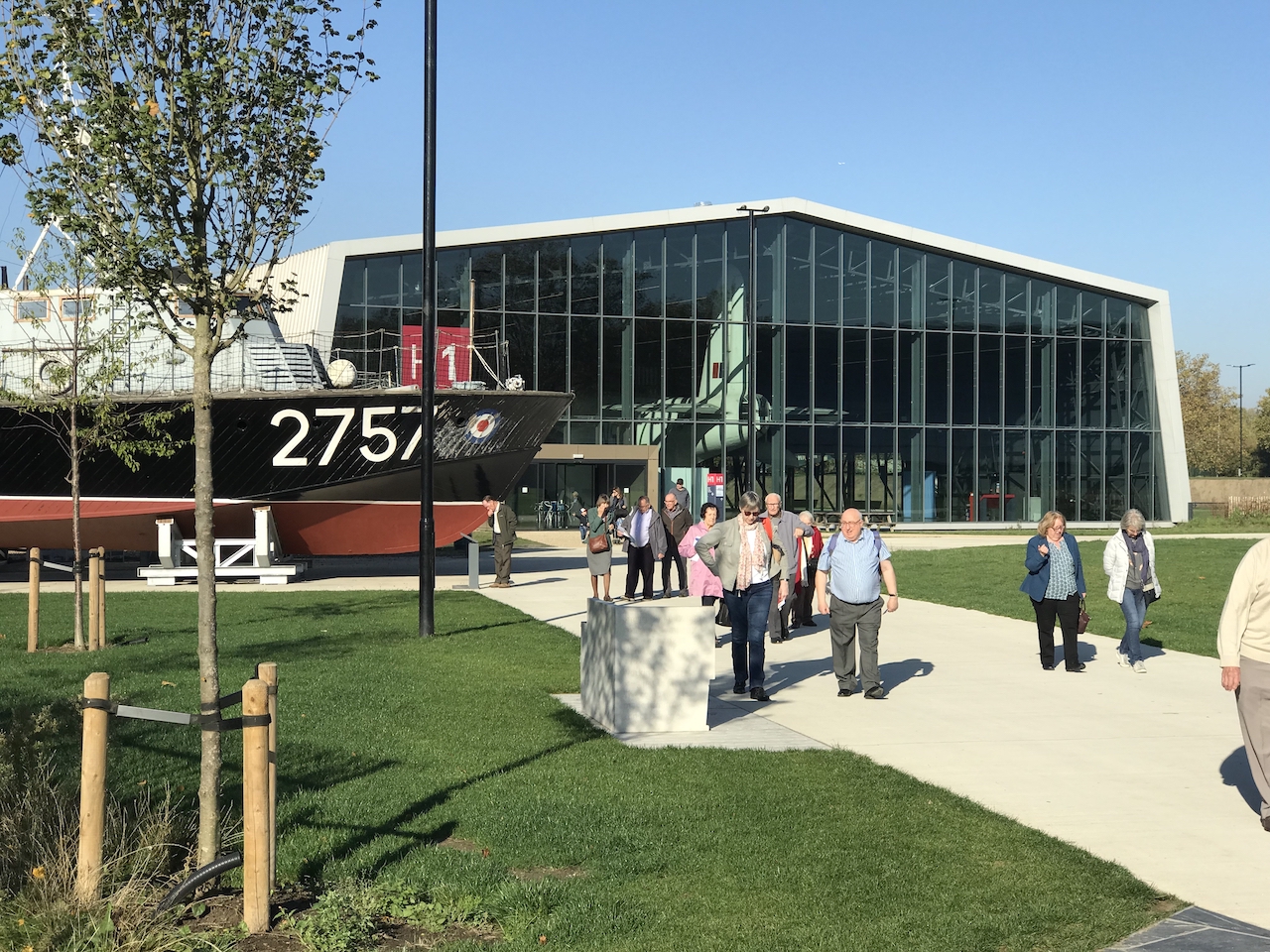April this year marked the centenary of the Royal Air Force and, commemorating the 100th anniversary, the RAF Museum in Hendon has been transformed with the addition of three new galleries and redeveloped grounds. 27 members of our club celebrated by visiting on a beautifully sunny October day; perfect flying (all right, driving) weather.
After morning coffee and pastries in 601 Squadron room, we divided into two groups for a conducted tour led by our two volunteer guides, Howard Clark and Steve Sierra, who were amazingly knowledgeable and interesting.
We started in Hangar 2, dating from about 1910 and apparently moved 500 yards, brick by brick, from near Colindale to its current location. Hendon was originally a private airfield and factory, building Bleriot aircraft for about five years before the war started. 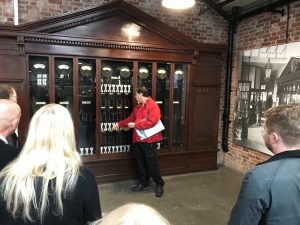 The owner would proudly show off the factory’s brand new electricity distribution system (equivalent to the consumer unit under your stairs) in glass-fronted cabinets as the latest technology.
The owner would proudly show off the factory’s brand new electricity distribution system (equivalent to the consumer unit under your stairs) in glass-fronted cabinets as the latest technology.
Louis Bleriot was, of course, the first person to fly across the English Channel (from France to England). A competition had been organised, but he realised that the real prize was not to win the race but to be the first person across. So, he got up early, in darkness, and took off at dawn’s first light while the other competitors were still in bed! Halfway across, his engine was overheating. He was lucky to spot a rain cloud and flew into it and around a couple of times, the rain cooling his engine a little, and then made it to England. However, he was lost and didn’t know where to find the airfield in Dover. He followed a railway line, then a road until he spotted some crowds obviously making their way to the airfield. Some kind souls in a car saw him gesticulating above and pointed the way; he found the airfield where he crash-landed safely (crash landings were not uncommon then).
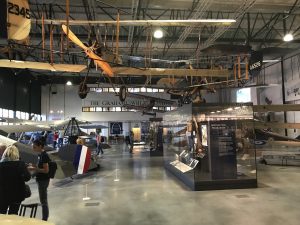 When World War I began, planes – and their armaments – developed very rapidly. At first, pilots were unarmed, just doing reconnaissance. But they soon started taking pot shots at each other with pistols. Louis Strange was one of the first aviators and had the idea of mounting a machine gun to the plane. He’d just done so when a German pilot overflew the airfield, so he ran to his plane – the first ever ‘scramble’ – and took off. Unfortunately, he couldn’t ‘get it up’, so to speak; the weight of the gun combined with the low power of his early aircraft meant that he just could not climb high enough to reach the German above.
When World War I began, planes – and their armaments – developed very rapidly. At first, pilots were unarmed, just doing reconnaissance. But they soon started taking pot shots at each other with pistols. Louis Strange was one of the first aviators and had the idea of mounting a machine gun to the plane. He’d just done so when a German pilot overflew the airfield, so he ran to his plane – the first ever ‘scramble’ – and took off. Unfortunately, he couldn’t ‘get it up’, so to speak; the weight of the gun combined with the low power of his early aircraft meant that he just could not climb high enough to reach the German above.
As engines became more powerful and aircraft grew faster, the next problem was how to fire a machine gun forwards without destroying the propeller. One early French pilot, Roland Garros (after whom the French tennis stadium is named, although he never played himself), had the idea of fixing metal plates to the propeller blades. This worked up to a point, but it could deflect bullets into the engine. Apparently Garros successfully shot down four Germans before then shooting himself down! The Dutch engineer Anthony Fokker (employed by the Germans) then invented synchronisation gear in which the propeller itself, by means of a cam, fires the gun at the appropriate time and enables the bullets to travel through the propellor’s arc.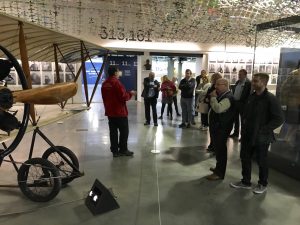
Planes developed at a rapid pace and those of 1917-18 bear little resemblance to those of 1914. The Sopwith Camel was arguably Britain’s deadliest fighter, but it killed more allied pilots than Germans; it was highly manoeuvrable but, in consequence, quite unstable and difficult to fly. The rotary engine’s rotational force also made it difficult and slow to roll left; apparently it was often faster to roll right three times (270 degrees).
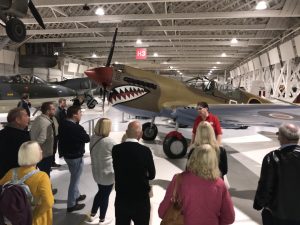 Moving on to the second world war and early jets in hangars 3, 4 and 5, we saw Spitfires, a Hurricane, Lancaster and others from the Allied Forces, plus a Messerschmitt, Heinkel and Stuka from the German side. This Stuka was the only one left of 13 captured after the war and had a starring role in the film ‘Battle of Britain’. For the film, it was in fact altered from its actual configuration as a ‘tank buster’ on the Russian front – the fixings for two large cannons on the wings are still there – and given a fake bomb underneath the fuselage to replicate the Stukas that bombed our radar stations.
Moving on to the second world war and early jets in hangars 3, 4 and 5, we saw Spitfires, a Hurricane, Lancaster and others from the Allied Forces, plus a Messerschmitt, Heinkel and Stuka from the German side. This Stuka was the only one left of 13 captured after the war and had a starring role in the film ‘Battle of Britain’. For the film, it was in fact altered from its actual configuration as a ‘tank buster’ on the Russian front – the fixings for two large cannons on the wings are still there – and given a fake bomb underneath the fuselage to replicate the Stukas that bombed our radar stations.
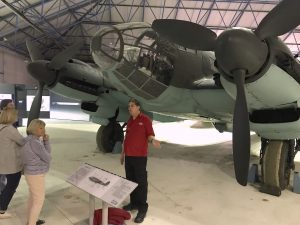 The Heinkel was also one of only two survivors, and studio copies of its cockpit were made for the film. This example survived apparently thanks to red tape and bureaucracy. It had been captured, repainted and left at the far end of a runway. At the end of the war, most old planes in German (or British) colours were simply scrapped but, being in American colours, they felt obliged to ask the USAAF whether they still wanted it. The reply took months, even years, to arrive, by which time the scrappers had moved on.
The Heinkel was also one of only two survivors, and studio copies of its cockpit were made for the film. This example survived apparently thanks to red tape and bureaucracy. It had been captured, repainted and left at the far end of a runway. At the end of the war, most old planes in German (or British) colours were simply scrapped but, being in American colours, they felt obliged to ask the USAAF whether they still wanted it. The reply took months, even years, to arrive, by which time the scrappers had moved on.
We ended our tour in Hangar 6, with the latest Eurofighter Typhoon and drone aircraft. We were somewhat surprised to be told the Typhoon is already obsolete, being a 4th generation fighter (1st = WW1, 2nd = WW2, 3rd = early jets, 4th = modern jets). The 5th generation fighters – such as the Lockheed F35 – are stealthy and use an entirely new form of radar which just ‘listens’ to the enemy and homes in without emitting any radar signals itself, except for an occasional millisecond burst. So they are effectively invisible to other aircraft. At a cost of £85 million each, apparently the UK intends to buy about 30.
It was a great day. Despite the 2½-hour guided tour, we just scratched the surface and there was so much more to see. After lunch most of us went off to explore further, but I’m sure it would be worth visiting again in a year or two.
Richard Gibby
